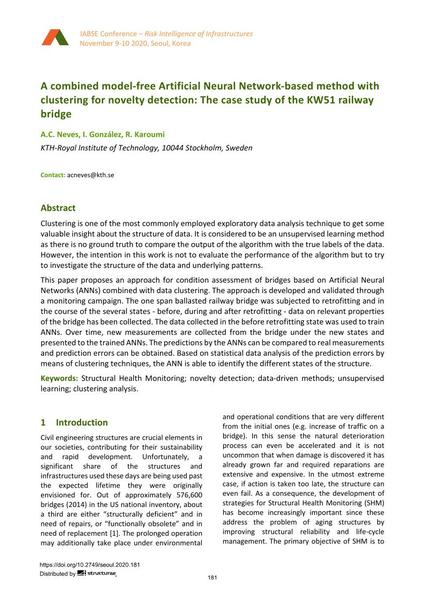A combined model-free Artificial Neural Network-based method with clustering for novelty detection: The case study of the KW51 railway bridge

|
|
|||||||||||
Détails bibliographiques
| Auteur(s): |
A. C. Neves
(KTH-Royal Institute of Technology, 10044 Stockholm, Sweden)
K. Maes (KTH-Royal Institute of Technology, 10044 Stockholm, Sweden) Ignacio Gonzalez (KTH-Royal Institute of Technology, 10044 Stockholm, Sweden) Raid Karoumi (KTH-Royal Institute of Technology, 10044 Stockholm, Sweden) |
||||
|---|---|---|---|---|---|
| Médium: | papier de conférence | ||||
| Langue(s): | anglais | ||||
| Conférence: | IABSE Conference: Risk Intelligence of Infrastructures, Seoul, South Korea, 9-10 November 2020 | ||||
| Publié dans: | IABSE Conference Seoul 2020 | ||||
|
|||||
| Page(s): | 181-189 | ||||
| Nombre total de pages (du PDF): | 9 | ||||
| DOI: | 10.2749/seoul.2020.181 | ||||
| Abstrait: |
Clustering is one of the most commonly employed exploratory data analysis technique to get some valuable insight about the structure of data. It is considered to be an unsupervised learning method as there is no ground truth to compare the output of the algorithm with the true labels of the data. However, the intention in this work is not to evaluate the performance of the algorithm but to try to investigate the structure of the data and underlying patterns. This paper proposes an approach for condition assessment of bridges based on Artificial Neural Networks (ANNs) combined with data clustering. The approach is developed and validated through a monitoring campaign. The one span ballasted railway bridge was subjected to retrofitting and in the course of the several states - before, during and after retrofitting - data on relevant properties of the bridge has been collected. The data collected in the before retrofitting state was used to train ANNs. Over time, new measurements are collected from the bridge under the new states and presented to the trained ANNs. The predictions by the ANNs can be compared to real measurements and prediction errors can be obtained. Based on statistical data analysis of the prediction errors by means of clustering techniques, the ANN is able to identify the different states of the structure. |
||||
